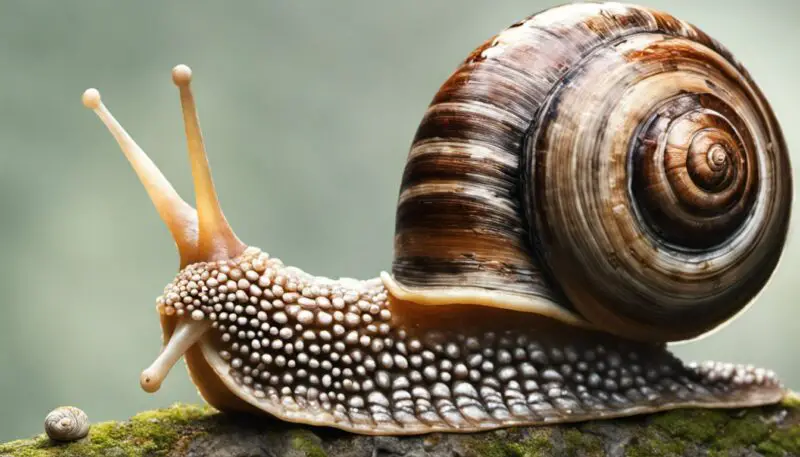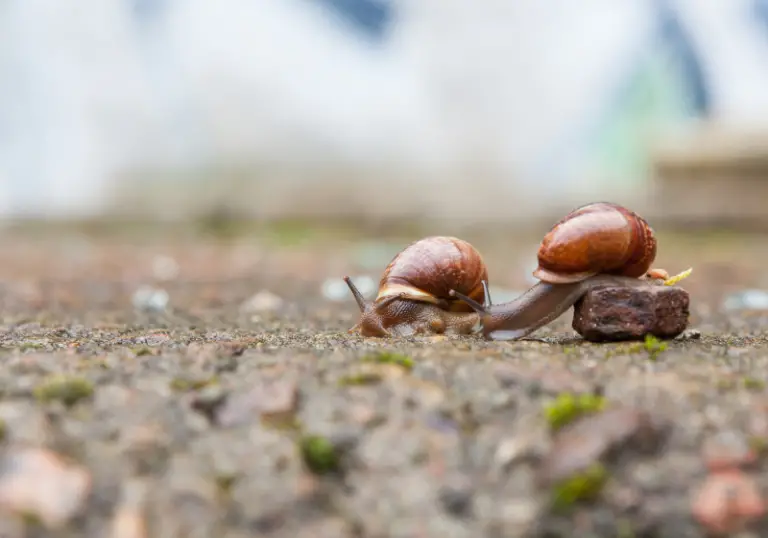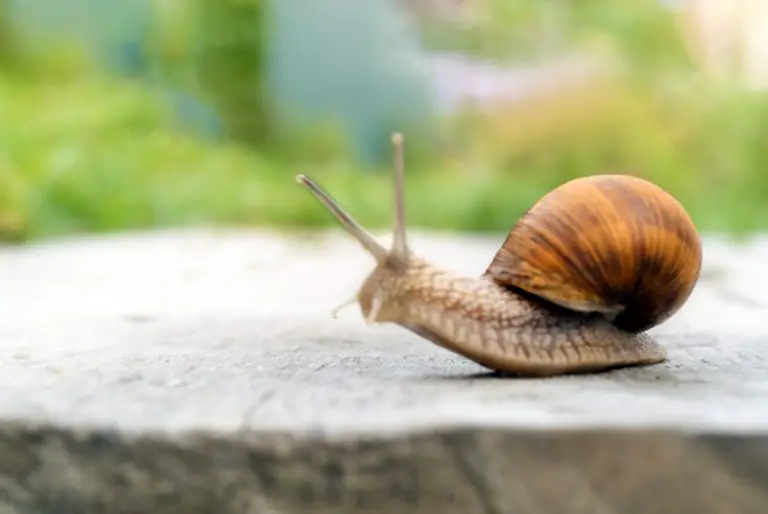A Snail’s Mantle

The snail’s mantle is crucial to its anatomy and overall survival. This unique part of a snail’s body is a dorsal body wall covering its visceral mass and often protrudes in the form of flaps extending beyond the internal organs. As a fascinating component of mollusk anatomy, understanding the mantle’s function is vital to knowing more about these intriguing creatures.

In the world of mollusks, which includes snails, the mantle has the important job of creating and maintaining shells. For those with shells, it secretes calcium carbonate and a matrix to form the protective exterior we often associate with snails. This process ensures that the snail is well-equipped to navigate its environment while staying safe from potential predators.
As you embark on your journey to better understand the snail’s mantle, remember its significance in mollusk anatomy and the critical tasks it performs for the survival and well-being of snails. By delving deeper into this topic, you will become more knowledgeable and confident in understanding these creatures and their unique features.
Contents
Table of Contents
The Mantle in Snails

The mantle in snails is a crucial part of their anatomy, significantly supporting their survival. As a mollusk, snails belong to the gastropod group, including slugs. The mantle is the fleshy lining of the outer wall of the shell, and it roofs the mantle cavity.
In snails with shells, the mantle secretes calcium carbonate and a matrix to form the shell, protecting the snail from predators and environmental conditions. The mantle is completely visible in slugs, which lack shells and do not serve the same protective function.
Another important aspect of the snail’s mantle is its role in forming and maintaining the mantle cavity. This cavity is a crucial part of the snail’s respiratory and excretory systems, allowing for the exchange of gases and the release of waste. Gills found within the mantle cavity help in respiration, while a variety of glands support the overall health and function of the cavity.
Different snails may have unique mantle colors and patterns, as seen in the land snail Indrella ampulla, which sports an off-white mantle partially visible under its shell. The head and foot of this particular snail are red, and the foot fringe is off-white with narrow black lines.
With the mantle playing a central role, Snail anatomy has adapted over time to fit these creatures’ various needs and environments. Whether providing shelter within a hardened shell or operating without one as a slug, the mantle remains a key component in the life and survival of gastropods like snails.
The Snail’s Shell

Structure of the Shell
The snail’s shell is a fascinating structure providing protection and support for the mollusk. The shell primarily comprises calcium carbonate, forming a solid, spiral-shaped structure on the snail’s back. This spiral shape gives the snail its distinctive appearance and helps distribute weight evenly, making the snail’s movements smooth and efficient. The shell’s interior is lined with layers of aragonite, a form of calcium carbonate crystals, and pearl-like material called mother-of-pearl.
As you observe a snail’s shell, you might notice that the spiral becomes tighter as it gets closer to the center. This is because the shell grows as the snail does, adding new layers to the outer edge of the spiral. This incremental growth results in a strong yet lightweight structure that serves as the snail’s home and primary defense against predators.
Material and Formation
The formation of a snail’s shell begins with a specialized body part called the mantle. The mantle secures calcium carbonate and a matrix, creating the hard outer shell. As the snail grows, the mantle continually deposits new layers of calcium carbonate and other materials, ensuring that the shell remains strong and durable.
Calcium carbonate is the primary component of a snail’s shell, as well as the primary component of many other seashell structures. In snails, calcium carbonate forms aragonite crystals, held together by a matrix composed of proteins and other organic materials. These crystals and the matrix create a complex, layered, strong, and lightweight structure.
As your understanding of snail anatomy grows, you can appreciate the intricate processes of creating the beautiful shells that adorn these slow-moving creatures. The combination of calcium carbonate, aragonite, and other materials form an architectural marvel that helps protect and support the snail throughout its life.
Snail Anatomy

Head and Tentacles
In snails, the head consists of a pair of tentacles, which serve as sensory organs. The upper pair of tentacles contain eyes, allowing the snail to detect light and movement, while the lower pair works as olfactory organs to smell1. Snails have a mouth on the head, typically equipped with a specialized feeding structure called the radula, used for scraping or cutting food.
Foot and Muscles
The foot is an essential part of a snail’s anatomy, enabling it to move. Snails have a strong, muscular foot that allows them to glide across surfaces by alternating contractions and expansions2. A cluster of nerve cells controls these movements called ganglia, which function as a simple brain. The body of a snail is attached to its shell by either a single columellar muscle or a series of muscles, providing support and protection3.
Mantle Cavity and Organs
The mantle cavity is a significant part of a snail’s anatomy, housing many vital organs and systems. It’s a dorsal body wall that covers the visceral mass, which includes the gonads, intestines, heart, and other organs4. In snails with shells, the mantle secretes calcium carbonate and a matrix to form the mollusk’s shell2.
Like the Achatinidae family, many snails are hermaphrodites, possessing both male and female reproductive organs5. Depending on the snail’s habitat, the gills or lungs are also located within the mantle cavity, facilitating respiration5. Other essential structures in the mantle cavity include the digestive and excretory systems, such as the intestine and kidneys4.
By understanding the snail’s head and tentacles, foot and muscles, and mantle cavity and organs, you can better appreciate these fascinating creatures and their adaptations to various environments.
Gastropods and Mollusks Classification

Mollusks, a diverse group of invertebrates, can be divided into gastropods, bivalves, and cephalopods. As you explore the world of mollusks, you’ll find that each classification presents unique characteristics and adaptations.
Gastropods are the largest class of mollusks, encompassing snails and slugs from saltwater, freshwater, and land environments. With their distinct coiled shells, gastropods usually carry a protective structure that houses the visceral mass, which contains vital organs like the digestive, reproductive, and respiratory systems. Notably, the mantle, a layer of tissue situated between the shell and the body, secrete calcium carbonate to form the shell itself.
Bivalves constitute another fascinating class of mollusks. These creatures, such as clams, oysters, and mussels, possess two hinged shells enclosing their soft bodies. Unlike other mollusk classes, bivalves lack a radula—a rasping, tongue-like structure used for feeding. Instead, they feed by filtering water through their gills, capturing small food particles in the process.
Cephalopods represent a more advanced mollusk class, including remarkable marine animals like squids, octopuses, and cuttlefish. Boasting highly developed eyes and nervous systems, cephalopods exhibit complex behaviors and impressive problem-solving abilities. Most members of this class have either an internalized shell or no shell at all, providing them with increased mobility and flexibility.
In addition to the three main classes discussed, there are also lesser-known mollusk classes such as Polyplacophora (chitons), Monoplacophora, Scaphopoda, and Aplacophora. For instance, chitons belonging to the class Polyplacophora sport eight overlapping shell plates that grant them protection and flexibility.
As you delve deeper into the fascinating world of mollusks, remember these classifications, which provide insight into their unique adaptations, behaviors, and ecological roles. And while exploring these creatures, you’ll undoubtedly appreciate the incredible diversity of life within the phylum Mollusca.
Mantle Collapse and Tears In Garden Snails: Watch this
Behavior and Adaptation
Feeding Habits
As a snail, your mantle plays a crucial role in your survival. Your feeding habits are diverse, depending on the type of snail you are. Some of you feed on plants and algae, while others are carnivorous, preying on insects or even other snails. You use your radula, a specialized toothed structure, to scrape or tear food, and your visceral mass containing internal organs helps with digestion.
Survival Mechanism
One of the key ways your mantle protects you is by aiding in gas exchange. In land snails, oxygen intake occurs through a network of thin-walled blood vessels in the mantle cavity under the shell. Losing water through breathing is a serious problem for you as a land snail. To prevent water loss, you have evolved a thick fold of skin in your mantle that closes off the cavity when necessary.
Your ability to fully retract your body into your shell is a defense against various predators. Doing so prevents dehydration, and your predator might lose interest. Your adaptation to different environments has also contributed to your survival over time. For instance, some of you have developed air-breathing lungs from your ancestral gills, allowing you to thrive in terrestrial environments.
Reproduction
Regarding reproduction, your mantle is essential, as it houses the brood chamber in some snail species. After mating, you lay your eggs in the brood chamber, where they are protected and nourished until hatching. As a hermaphroditic creature, you possess both male and female reproductive organs, which helps to increase your chances of successful reproduction.
Your mantle and its various functions play a significant role in your feeding, survival, and reproduction, contributing to your diverse behavioral patterns and evolutionary adaptations.
Snail Species Variation

Marine Snails
Marine snails, as their name suggests, inhabit ocean environments. They vary greatly in size and shell characteristics, with some even lacking a shell and resembling a slug. The shells can be round or cone-shaped, displaying a cosmic array of colors. This diversity helps marine snails adapt to their surroundings, camouflaging them from predators.
Freshwater Snails
On the other hand, freshwater snails live in lakes, rivers, and streams. They vary in size like their marine counterparts and have different shell shapes for their unique habitats. Some snails have round shells, while others have more spiral designs. The color and size variations serve as a means of survival in diverse freshwater ecosystems.
Land Snails
Land snails are the most familiar type, typically found in gardens and forests. They, too, have a wide range of sizes, shell shapes, and colors. Land snail shells often have a spiral design, which protects them from environmental threats and predators. Some species have shells so reduced in size that they cannot contain the body, making them look more like slugs. These snails adapt to their terrestrial habitats using their unique anatomy and varying shell characteristics.
Snails in Human Society

Culinary use
You might be surprised to learn that snails have been a part of human cuisine for centuries. The consumption of snails, known as escargot, is especially popular in French cuisine. Many land snail species are considered a delicacy and are prepared in various ways, such as cooked in garlic butter or added to stews and sauces. Make sure to try them if you want to expand your culinary horizons.
In popular culture
Snails have also found their way into popular culture, often portrayed as slow-moving and peaceful creatures in children’s stories, movies, and TV shows. Their unique appearance, with their coiled shell and tentacles, makes them easily recognizable and memorable characters in various media. Keep an eye out for these fascinating invertebrates next time you watch a nature documentary or animated film.
Economic impact
An interesting aspect of snails in human society is their economic impact. Besides their culinary value, some snail species are used to produce natural snail mucus for cosmetic and skincare products, which have become increasingly popular in recent years. Moreover, the shells of certain snails have been utilized in crafting jewelry and buttons, adding to their economic importance. Being mindful of their contributions to various industries, you might develop a greater appreciation for these versatile creatures.
Frequently Asked Questions: Snail’s Mantle
What is the purpose of a snail’s mantle?
A snail’s mantle is an essential part of its body, forming the outer wall and enclosing the internal organs, such as the heart, stomach, intestines, and gonads. The mantle is muscular, and in many species, it is modified for siphoning water for feeding and propulsion.
How does the mantle cavity function in snails?
The mantle cavity in snails acts as a respiratory chamber and houses important organs such as the gills. It provides a space for gas exchange, allowing snails to breathe, and in some aquatic species, the cavity is highly vascularized, facilitating the efficient transfer of oxygen, carbon dioxide, and other waste products into and out of the body.
What role does the mantle play in mollusk respiration?
In mollusks like snails, the mantle is responsible for respiration. The mantle cavity contains the gills or lungs, which extract oxygen from the surrounding environment. This process allows the mollusk to breathe and maintain proper metabolic function.
Can a snail survive if its mantle collapses?
If a snail’s mantle collapses, it could lead to serious health issues, and possibly death. The mantle collapse is a condition wherein the mantle separates from the shell, potentially causing the loss of internal support for organs. Unfortunately, the direct cause of mantle collapse and the best course of treatment are still poorly understood.
What leads to a snail’s mantle collapse?
It is not entirely known what causes a mantle collapse in snails. Contributing factors could include injury, stress, or disease. Proper care, including maintaining an appropriate environment and a healthy diet, are crucial to ensuring the overall health and well-being of your pet snail.
How is the function of a snail’s mantle different from that of a clam or squid?
While all three animals – snails, clams, and squids – belong to the phylum Mollusca, their mantles have distinct functions. In snails and clams, the mantle secretes and maintains the shell, while in squids, the mantle is primarily a part of the muscular system, responsible for swimming and jet propulsion. The respiratory function varies as well; mollusk species possess gills or lungs in their mantle cavities, adapted to their specific environment, be it aquatic or terrestrial.



![What Do Apple Snails Eat? [Full Guide]](https://allourcreatures.com/wp-content/uploads/2021/10/what-do-apple-snails-eat-768x512.jpg)


